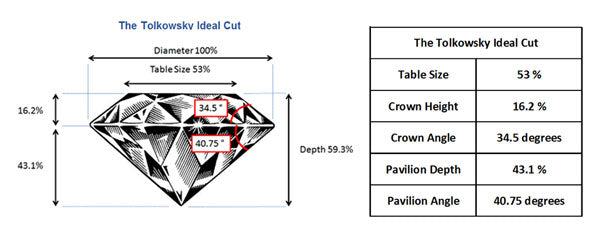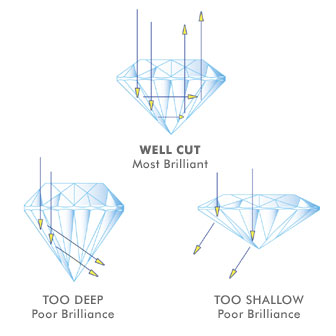A diamond’s cut determines how much light the stone reflects. The diamond may have great colour, clarity and carat, but if it reflects only a little light it will be dull and lifeless, while a diamond with a great cut will emanate fire, sparkle and allurement.

As we talk about diamond cut, don’t confuse it with diamond shape. A diamond’s cut refers to the symmetry of its facets, the measurements of its angles and much more. A diamond’s shape refers to its external form, which can be round, oval, cushion or heart-shaped, among others.
Before we explain more about diamond cut, let’s briefly consider how diamond cutting has evolved since it first began in the Middle Ages.
The History of Diamond Cutting
Rough diamonds come in all shapes and sizes and in their natural state are far from spectacular. Diamonds must be cut to reveal their inner beauty.
Jewellers first began to realize this in the middle of the 1400s. They discovered that the crystals within rough diamonds were octahedrals and began polishing these 8 natural facets to improve the stone’s usability and beauty. This form of polishing diamonds is now known as the point cut.

In the 16th and 17th centuries, jewellers experimented with adding additional facets to diamonds. Rosette-cut diamonds with triangular facets arranged in a radiating pattern were introduced to the diamond market in Antwerp, while Peruzzi-cut diamonds with 33 facets on their crown became popular in Italy.
Each of these early diamond cuts contributed to the development of the old European cut in the 1800s. The Old European cut gave diamonds 58 facets, as well as a smaller table, larger culet and more depth than their earlier counterparts. The old European cut set the stage for the round brilliant cut that we prize today.
As the 20th century dawned, jewellers began using more precise saws and state-of-the-art lathes as they shaped diamonds and a Polish engineer named Marcel Tolkowsky began to systematically study the old European cut. Tolkowsky carefully calculated how much white light old European cut diamonds reflected and evaluated the fire that appeared as the white light was dispersed in all the colours of the rainbow.
Marcel Tolkowsky then mathematically redesigned every aspect of the old European cut. His stunningly beautiful, new diamond cut became known as the round brilliant cut, because it maximized the brilliance, fire and sparkle of every diamond crystal.

Today approximately 75% of all the diamonds used in engagement and wedding rings, as well as other jewellery, are full of life and light thanks to the round brilliant cut.
Now let’s carefully consider the primary aspects of a diamond’s cut.
The Science Behind Diamond Cutting
The best gemologists take time to study the rough diamond, before they begin to cut it. As they study it, they consider its grain, any flaws that it has and its precise measurements. They then decide how to give it symmetry, proportion and polish to bring out the beauty in that particular stone.
Here is how gemologists explain symmetry, proportion and polish in relation to diamonds:

Symmetry – The best diamonds are perfectly symmetrical. This means that the facets on any of its sides are exactly similar to the facets facing them across the diamond’s axis.
Today’s round brilliant cut diamonds have 58 facets, if they have a culet, and 57 facets without a culet. Gemologists have named the facets so that they can be very specific in their work. On the crown of a diamond, the star, kite and upper girdle facets surround the diamond’s table, while lower girdle and pavilion facets stretch from the diamond’s girdle down to the culet.
Proportions – A diamond’s proportions are almost always based on Tolkowsky’s ideal diamond design. Tolkowsky used the diamond’s diameter as the basis for his calculations and concluded that for optimal light reflection:
- The total depth of the gem should be 59.3% of the diameter.
- The diamond’s table should measure no more than 53% of the diameter.
- The height of the diamond’s crown should be 16.2% of the diameter.
- The depth of the diamond’s pavilion should be 43.1% of the diameter
- The diamond should have a crown angle of 34.5 degrees.
- Lastly, the diamond should have a pavilion depth of 40.75 degrees.

As gemologists decide what proportions they are going to give a diamond, they pay special attention to the correlation between the diamond’s carat weight and its diameter. If they give a diamond with a small carat weight a large diameter, the resulting gem will be shallow and lose light through the sides. A heavy diamond with a diameter that is too small will also lose light through its pavilion because it is too deep.
To produce the ideal diamond, gemologists must find the perfect balance between a diamond’s carat weight and the measurement of its diameter, so that all the light that enters the stone will be reflected back out of the crown.

Polish – One of the final steps in the diamond cutting process is polishing, because all diamonds pick up minor surface blemishes as they are cut and these flaws obstruct the reflection of light. Diamonds are polished with diamond dust and other abrasive agents to smooth the surface of the diamond, so that light can enter and exit the gem without interference.
Skilled gemologists pay attention to the symmetry, proportions and polish of any well-cut diamond, but on approximately 1% of diamonds they double their efforts in order to make hearts and arrow diamonds.
Hearts and Arrow Diamonds – The Japanese are credited with creating the first heart and arrow diamonds in the 1980s. Japanese jewellers optimized the diamonds’ symmetry, modified the faceting pattern and spent extra time polishing the stones. The result was exceptional diamonds that have eight internal, symmetrical arrows when they are viewed from the top and eight internal, symmetrical hearts when viewed from the bottom.

Today hearts and arrow diamonds are made by jewellers all around the world. Although they cost a little more than round brilliant diamonds, heart and arrow diamonds are worth the investment because they are exceptionally brilliant and have the special touch of having hearts hidden in them.


